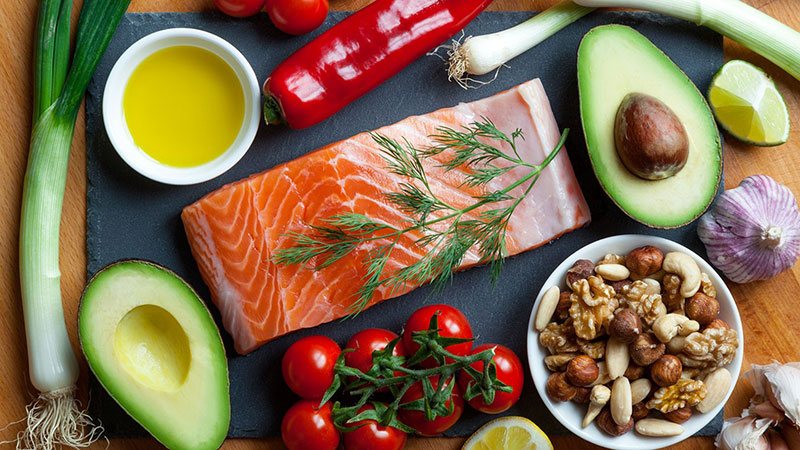Zone Diet
The Zone diet involves reducing intake of carbohydrates to ensure healthy insulin levels, and consuming plenty of omega-3 fatty acids and polyphenols. The goal of the diet is to reduce inflammation. It was developed by Dr. Barry Sears, over 30 years ago, as a remedy for reducing diet-induced inflammation, because many conditions and diseases having been discovered to involve inflammation. These conditions and diseases can range from digestive issues to the onset of cancers. The diet aims to help individuals shed excess pounds, while also improving mental and physical performance.
The Zone Diet® is described by The Zone Diet® website as “a life-long dietary program based on strong science to reduce diet-induced inflammation.” It further describes the Zone as “a real physiological state in your body that can be measured in clinical tests.” The Zone is the physical state that the program identifies as the ideal state for the human body to be in and the sole aim of the diet is to bring the person into that state.
The program recommends testing three blood values to determine if a person is in “the Zone.”
- TG/HDL ratio-From diet: A ratio of “bad” fats or triglycerides to “good” or HDL cholesterol in the blood; used to determine the level of insulin resistance in the liver and available within the normal cholesterol panel. The ideal level for the zone is less than 1.
- AA/EPA ratio-From diet & fish oil: A value that indicates the level of diet-induced inflammation within the body. The recommended level is a low score between 1.5 and 3. A higher number is indicative of higher risk of obesity, depression and chronic disease. This value is obtained from the Zone Labs Cellular Inflammation Test.
- HbA1c-From diet & Polyphenols : Indicates Advanced Glycoslated Endproducts (AGE) tied to the individual’s blood glucose. It shows average blood sugar levels over the past three months. The ideal level recommended for the zone is 5%. The test is available from doctors everywhere.
Individuals on Zone diet will get 3 meals and 2 snacks a day. Each of which will be a of low-fat protein, carbs and a little quantity of “good” fat. Carbs within the diet must have a low glycemic. Glycemic Index Foundation’s website defines the Glycemic Index (GI) as “a relative ranking of carbohydrate in foods according to how they affect blood glucose levels. Carbohydrates with a low GI value (55 or less) are more slowly digested, absorbed and metabolized and cause a lower and slower rise in blood glucose and, therefore usually, insulin levels.”
The Zone Diet® helps to shed excess pounds and improve performance, while allowing the individual to live a more fulfilling life. The Zone website says that if a person is in the zone, they will have optimized their ability to control diet-induced inflammation. The diet involves a few basic rules:
- The first meal or snack of the day must be eaten no later than an hour after waking up in the morning.
- There should be a 4 to 6 hours interval between meals.
- Regardless of whether a person is hungry or not, they must eat a meal between 2 to 2.5 hours after a snack.
- Individuals are expected to drink eight 8-ounce glasses of water per day.
Additionally, portions in the zone diet are measured using two methods.
The Hand-Eye Method where the hand is used to determine portion size, as a reminder to eat five times daily, and never to stay longer than five hours without food. The eye is also used to gauge portions.
Zone Food Blocks are used to personalize the diet by calculating daily grams of protein, carbs and fat the individual can have per day. The number of Zone blocks eaten per day is determined by measurements of individuals’ weight, height, waist and hips.
Pros and Cons of the Zone Diet
Pros
Individuals using this diet have been able to lose excess body fat at the fastest possible rate
It also helps to maintain a person’s wellness for longer periods
People on the diet have reported better all-round performance
There are also reports of more clarity of thought among followers of the diet
The diet slows the aging process
Cons
The diet has an inflexible 30% protein, 30% fat, and 40% carbs formula, which must be followed at every meal and snack.
The Zone diet’s recommendation to avoid certain fruits and vegetables is questionable because these are deemed necessary for a balanced diet.
Who this eating plan is for?
- Persons who are highly concerned about the risk of losing muscle rather than fat
- Persons who are looking for a gluten-free weight-loss diet.
- It is an easy fit for vegetarians
- People who need flexible in a weight-loss diet; other than the fixed formula, the diet is not excessively restrictive in food choices.
- Individuals looking for a diet with similar food options to the Mediterranean Diet
Foods Allowed and Disallowed in a Zone diet
Allowed
- Lean Proteins
- Monosaturated fats
- Low glycemic-index carbs,
Disallowed
- High-sugar fruits
- High-sugar or starchy vegetables
- Refined and processed carb
- Low and no sugar soft drinks
- Coffee and tea
Athletic Performance on The Zone Diet
Due to it being an energy-restricted diet, athletes on a Zone diet could easily slip into an energy-deprived state that could ultimately prove damaging to their performance.
Medical studies on the Zone plan
Due to its similarity to the Mediterranean Diet, which is backed by a significant body or research, there is reason to treat the diet’s claims with credibility.
The Zone Food Block method is proven to help achieve fat loss due to its control of how many calories individuals eat per day.
Although some research does show that the diet improves blood values, further study is required to conclusively determine if the diet significantly reduces inflammation in the body.





